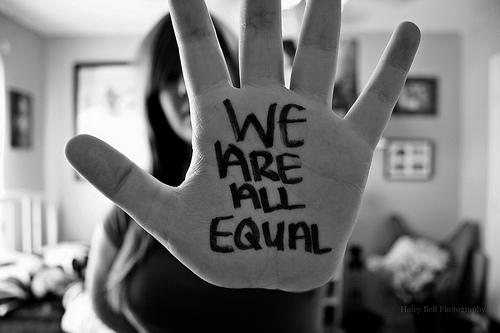Equality is an issue that is discussed in different settings, including the college one. “We are all equal” is a message presented in the photograph made by Haley Bell, a college student. In spite of the fact that the photograph is rather straightforward in its message, it is important to focus on this image of a young white woman’s hand with words saying that we are all equal, and the purpose of this analysis is to determine whether the message presented in such a way can be effective to persuade the audience. Thus, although the photograph conveys a message in a direct manner, it can be discussed as effective to attract the young audience because of discussing the issue close to them and appealing to the young people with the focus on logos, ethos, and pathos.
Origin of the Image
The discussed photograph demonstrating the palm of the young white woman’s hand with the words on it was made by Haley Bell, a college student interested in photography. The photograph was taken in the dormitory room of Haley’s friends, and it belongs to a series of photographs representing persons’ palms with messages on them. The discussed photograph presents the message written in bold letters with a black marker that states, “We are all equal.”

Rhetoric Appeals
When referring to the image conveying a message, it is important to ensure that it is based on used pathos, ethos, and logos in order to impact the target audience. In this context, logos is used when the author wants to convince the audience, referring to reasoning and values. The photographer uses logos while presenting the message about equality on palms that almost always seem to be of the same color, without references to a person’s skin color. The author tells the audience that in case they doubt the message, they can simply look at their palms. They will see that the color is the same, and all of them have five fingers to emphasize the fact that they are actually equal.
Ethos is another rhetoric appeal that works to demonstrate the author’s credibility in terms of accentuating the experience or reputation. The author of this photograph and message is a young white woman who studies at college, and she is part of the diverse community of students. Emphasizing the message of equality, the author identifies herself with the audience in spite of being white and representing a white girl in the photograph; thus, she rejects the privileges of the white people in society.
The fact that both the author and character are females is also important to explain the message of equality. In this context, inequality can also be associated with the factor of gender discrimination in society. From this point, the author accentuates her credibility while identifying herself both with the character in the photograph and the audience for whom the message is close and important.
Pathos is used when the author chooses to use the emotional appeal to attract the target audience and cause certain feelings to make the message more convincing. In the case of the image, the audience may want to know why such a young woman is concentrated on emphasizing that people are equal. Focusing only on the message, the author evokes the feelings of confidence and courage in those who can feel inequality in their everyday life. Using the words “we” and “all”, the author is able to make the message close to everyone, while causing the feeling of unity. The audience becomes sure that they are part of a society where everyone is equal.
Intended Audience
Referring to the information about the author of the photograph, it is possible to conclude that the intended audience includes young adults of different backgrounds, races, and genders, studying at college. Thus, the message is oriented to attract the audience who can guess in what settings the picture was taken and what problems were emphasized with the help of the message.
Focusing on the effectiveness of the image to attract and persuade the intended audience, it is possible to state that the photograph is effective in convincing young college students that equality is related to everyone. The author effectively uses rhetorical appeals in order to state that she is one of the community, and in this environment, everyone is equal. Thus, the message is meant to encourage equality in colleges while demonstrating that students have more features that make them equal than those that make them different.